Challenge 10 – Shadow Speed and Earth’s Rotation
The shadow of the moon travels west to east across Earth’s surface at the same time that Earth’s surface is moving west to east due to the rotation of Earth around its axis. This means that the actual shadow speed is actually greater than what you measure on the surface of Earth. Here’s how to figure this out!
Earth rotates once every 23h 56m (23.933h), so at the equator where Earth’s circumference is 2ΠR = 2x3.14x6378 km = 40,000 km it has to travel at a speed of Vrot = 40000km/23.933h = 1,674 km/hr.
But as we travel away from the equator towards the poles, the circumference decreases according to C = 40000 cos(latitude) and so its speed from west to east also decreases according to
At the start of the eclipse in Oregon, for a latitude of 44.8o, its speed due east is Vrot=1188 km/hr, but when we reach the South Carolina coast the rotation speed of Earth there at the lower latitude has increased to Vrot = 1674cos(33.0) = 1403 km/hr.
Problem 1 – Suppose that an observer uses their stopwatch near Casper, Wyoming at a latitude of 42.8 North and determines a shadow speed of 2,800 km/hr. What is the actual shadow speed allowing for the rotation of Earth?
Problem 2 – In 1973, a team of British and French astronomers were able to fly their equipment on a test flight of the French Concorde supersonic passenger jet across Africa at an altitude of 56,000 feet and a speed of Mach 2.0 or 2,100 km/h, chasing the lunar shadow the whole way. If the latitude of the observations was 19.0 North, and the ground speed of the shadow at this latitude was 2,200 km/h,
- What was the true speed of the shadow, and its speed relative to the Concorde flight?
- If the diameter of the shadow was 250 km, how long did it take for the Concorde to travel across the shadow?
Here is an image from space of what the lunar shadow looks like. It was obtained with NASA’s Earth Polychromatic Imaging Camera on the Deep Space Climate Observatory (DSCOVR) satellite, which orbits our planet at a distance of 1.6 million kilometers.
DSCOVR eclipse
Credit: NOAA / NASA / DSCOVR







